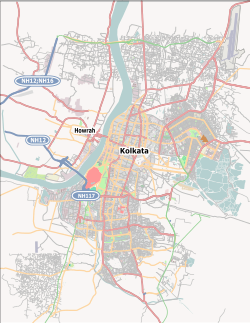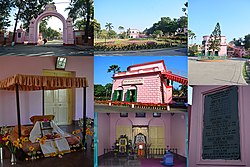Cossipore
Cossipore | |
|---|---|
Neighbourhood in Kolkata (Calcutta) | |
 Sarbamangala Chitteshwari Temple, Cossipore | |
| Coordinates: 22°37′23″N 88°22′30″E / 22.623°N 88.375°ECoordinates: 22°37′23″N 88°22′30″E / 22.623°N 88.375°E | |
| Country | |
| State | West Bengal |
| City | Kolkata |
| District | Kolkata |
| Metro Station | Dum Dum |
| Municipal Corporation | Kolkata Municipal Corporation |
| KMC wards | 1, 6 |
| Elevation | 36 ft (11 m) |
| Population | |
| • Total | For population see linked KMC ward page |
| Time zone | UTC+5:30 (IST) |
| PIN | 700002 |
| Area code | +91 33 |
| Lok Sabha constituency | Kolkata Uttar |
| Vidhan Sabha constituency | Kashipur-Belgachhia |
Cossipore (also spelt Cossipur, Kashipur) is a neighbourhood of North Kolkata, in Kolkata district in the Indian state of West Bengal. One of the oldest neighbourhoods of the metropolis, it has a police station.[1]
History[edit]
The East India Company obtained from the Mughal emperor Farrukhsiyar, in 1717, the right to rent from 38 villages surrounding their settlement. Of these 5 lay across the Hooghly in what is now Howrah district. The remaining 33 villages were on the Calcutta side. After the fall of Siraj-ud-daulah, the last independent Nawab of Bengal, it purchased these villages in 1758 from Mir Jafar and reorganised them. These villages were known en-bloc as Dihi Panchannagram and Cossipore was one of them. It was considered to be a suburb beyond the limits of the Maratha Ditch.[2][3][4]
H. E. A. Cotton writes, "The Cossipore Reach was one of the finest on the river, and is lined by a number of villa residences." From those days Cossipore had a number of industrial units. – the Government Gun Foundry, the Snider and Rifle Shell factories (originally constructed by Colonel Hutchinson), sugar mills and jute screw houses.[5]
Entally, Manicktala, Beliaghata, Ultadanga, Chitpur, Cossipore, parts of Beniapukur, Ballygunge, Watgunge and Ekbalpur and parts of Garden Reach and Tollygunj were added to Kolkata Municipal Corporation in 1888. Garden Reach was later taken out.[6]
Geography[edit]
KMC ward[edit]
Ward No. 1 and Ward No. 6 of Kolkata Municipal Corporation cover Cossipore. It has six prominent ghats on the Hooghly – from south - Cossipore Ghat, Sadhur Ghat, Ranir Ghat, Pramanick Ghat, Ramakrishna Mahasashan and Ratan Babu Ghat.[7]
Police district[edit]
Cossipore police station is part of the North and North Suburban division of Kolkata Police. Located at 58/A, Barrackpore Trunk Road, Kolkata-700002, it has jurisdiction over Cossipore neighbourhood/ Ward No. 1 of Kolkata Municipal Corporation.[8][9]
Amherst Street Women police station covers all police districts under the jurisdiction of the North and North Suburban division i.e. Amherst Street, Jorabagan, Shyampukur, Cossipore, Chitpur, Sinthi, Burtolla and Tala.[8]
Transport[edit]
Cossipore Road (Sri Sri Ramakrishna Paramahansa Dev Sarani) is the artery of the area. The road is connected to B.T. Road (at Chiria More) with Khagendra Chatterjee Road.[10]
Bus[edit]
Private Bus[edit]
- 34B Dunlop - Esplanade
- 43 Dakshineswar - Esplanade
- 242 Cossipore 4B - Esplanade
CSTC Bus[edit]
- S17A Ariadaha - Kudghat
Train[edit]
Kolkata Station (one of the major railway hub stations of the city) and Dum Dum Junction are the nearest railway stations. Tala railway station and Bagbazar railway station on Kolkata Circular Railway line are also located nearby.
Economy[edit]
Gun and Shell Factory[edit]
The more than two centuries old Gun and Shell Factory at Cossipore is the oldest surviving factory in the Indian subcontinent. It was set up in 1802 and functions under the Ordnance Factories Board. Along with technological evolution, the plant has successfully altered its product mix to suit the requirements of changing times. The plant has recently undergone large scale modernisation. Its product-mix ranges from big barrel guns to small barrel pistols, different varieties of shells and fuses and civil trade items.[11][12]
It started off as Gun Carriage Agency, but after shifting of the agency first to Allahabad in 1814, and then to Fatehgarh in 1816, its importance was diminished. Finally in 1829, all the machines were shifted to Fatehgarh. However, it had the strength of springing back to life again and again. The vacant space was utilised for the much-needed expansion and renovation of the Gun Factory of Fort William. Besides casting of brass guns, it also took up manufacture of iron shot and shells.[11][12]
Around 1855, breech-loading steel rifled guns had got its way to the British arsenal, but the Cossipore plant was not properly equipped to undertake manufacturing of such guns. The mini-bullet factory was transferred to Dumdum. It had little work and there were suggestions for its closure but it survived. The rifled guns, imported from England, required new elongated shells. It was decided that Cossipore would be utilised for manufacturing of the new shells. It underwent some expansion and the name ‘Gun Foundry’ was changed to ‘Foundry and Shell Factory’ in 1872. Along with the manufacturing of new elongated shell, there was requirement of undertaking manufacturing of modern fuses and cartridges to match the newly introduced breech-loading guns. So further expansion took place in 1887 and 1890.[11][12]
In 1892, steel was, for the first time cast in India, at Cossipore by a Siemen's Martin Open Hearth Plant. In 1896, a rolling mill was erected. However, the metallurgical units were shifted to Ishapore in 1903 as no further space for expansion was available at Cossipore. In 1890, a shop was erected for the manufacture and repair of fittings of imported breech-loading guns. The plant undertook the manufacture of quick-firing guns in 1905. With the return of the manufacturing of guns, the name of Cossipore unit got the present name of ‘Gun and Shell Factory’ in 1905.[11][12]
Cossipore Electric Generating Station[edit]
New Cossipore Generating station started producing electric for CESC from the year 1949 and has current capacity of 100 MW. This is older and uses non Pulverized Fuel to generate electricity. This unit plays a major part creating an economic eco system in its own. There are a lot of people live in Cossipore who are part of that ecosystem. But in 2015 it was closed.
Culture[edit]
The branch of the Ramakrishna Math at Cossipore is popular as Udyanbati.[13] This garden house was sanctified by Ramakrishna's stay with his disciples during the last few months of his life, as also by his mahasamadhi. It was made a branch of Ramakrishna Math in 1946.[14] Kalpataru Utsab is organised on 1 January every year.[15]
Gallery[edit]
External links[edit]
References[edit]
- ↑ "Cossipore Police Station". Kolkata Police. Archived from the original on 8 June 2007. Retrieved 16 January 2008.
- ↑ "District Census Handbook Kolkata, Census of India 2011, Series 20, Part XII A" (PDF). Pages 6-10: The History. Directorate of Census Operations, West Bengal. Retrieved 20 February 2018.
- ↑ Cotton, H.E.A., Calcutta Old and New, first published 1909/reprint 1980, pages 103-4 and 221, General Printers and Publishers Pvt. Ltd.
- ↑ Nair, P.Thankappan, The Growth and Development of Old Calcutta, in Calcutta, the Living City, Vol. I, pp. 14-15, Edited by Sukanta Chaudhuri, Oxford University Press, 1995 edition.
- ↑ Cotton, H.E.A., Calcutta Old and New, 1909/1980, p. 221, General Printers and Publishers Pvt. Ltd.
- ↑ Bagchi, Amiya Kumar, Wealth and Work in Calcutta, 1860-1921, in Calcutta, the Living City, Vol. I, edited by Sukanta Chaudhuri, p. 213, Oxford University Press, ISBN 978-0-19-563696-3.
- ↑ Detail Maps of 141 Wards of Kolkata, D.R.Publication and Sales Concern, 66 College Street, Kolkata – 700073
- ↑ 8.0 8.1 "Kolkata Police". North and North Suburban Division. KP. Archived from the original on 30 March 2018. Retrieved 5 March 2018.
- ↑ "Table 3 District Wise List of Statutory Towns (Municipal Corporation, Municipality, Notified Area and Cantonment Board), Census Towns and Outgrowths, West Bengal, 2001". Census of India 2001. Census Commission of India. Archived from the original on 21 July 2011. Retrieved 17 July 2016.
- ↑ Google maps
- ↑ 11.0 11.1 11.2 11.3 "Cossipore Gun and Shell Factory". globalsecurity.org. Retrieved 16 January 2008.
- ↑ 12.0 12.1 12.2 12.3 "Two Centuries of Guns and Shells". Sainik Samachar. Archived from the original on 7 February 2012. Retrieved 16 January 2008.
- ↑ Udyanbati
- ↑ "Ramakrishna Math and Mission". belurmath.org. Archived from the original on 15 January 2008. Retrieved 16 January 2008.
- ↑ "Kalpataru Utsab at Udyanbati, Cossipore". The Telegraph, 2 January 2007. Retrieved 16 January 2008.




